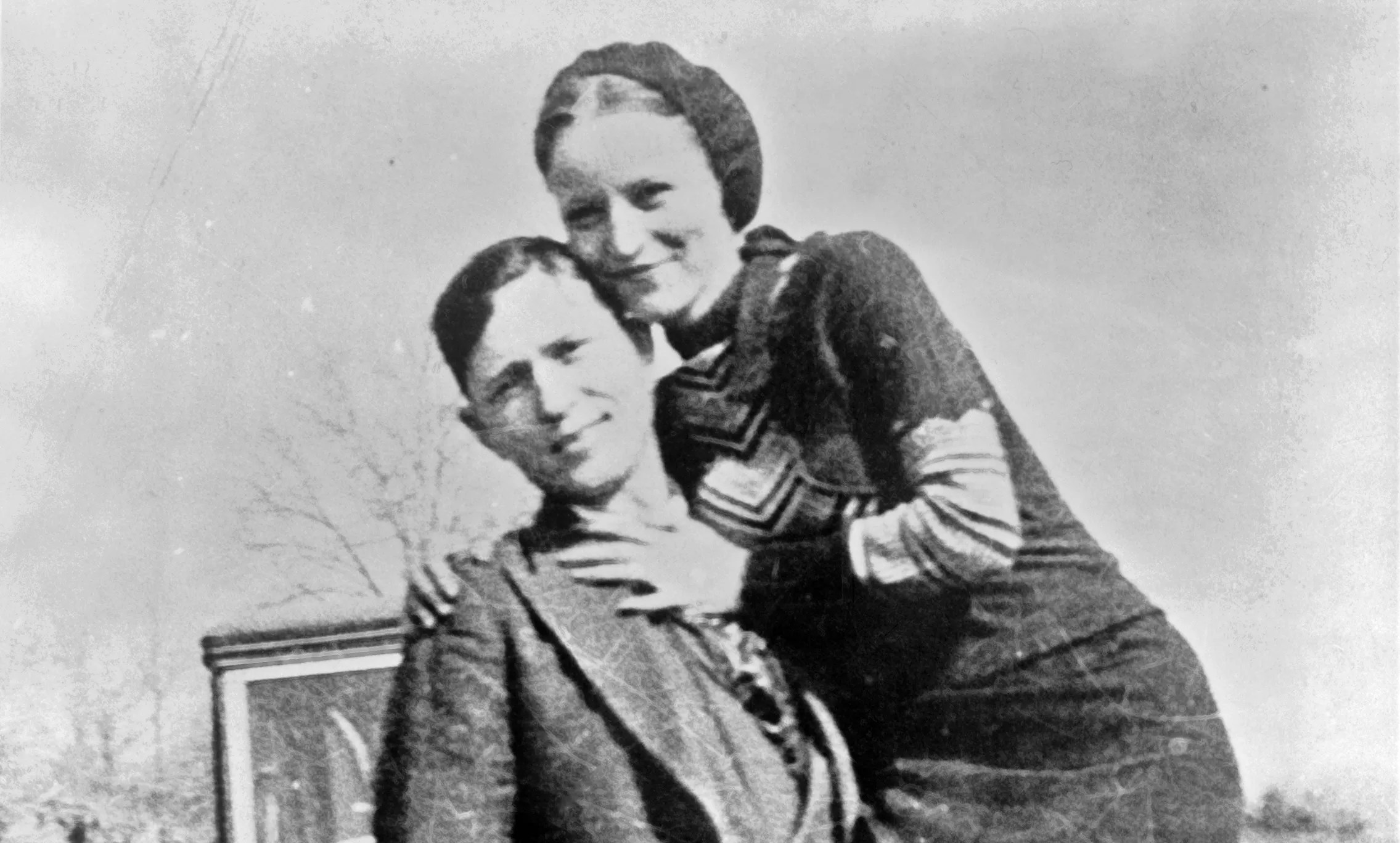
Bettman/Getty Images

Audio By Carbonatix
Eighty-five years after their deaths, Bonnie Parker and Clyde Barrow are inescapable.
They’re in The Highwaymen, released this year on Netflix. Kevin Costner and Woody Harrelson star as Frank Hamer and Maney Gault, former Texas Rangers who helped bring the Barrow Gang’s gruesome, two-year spree of 13 murders and numerous robberies to an equally gruesome end.
They’re on Hulu’s true crime show The Act, about a woman who commits matricide with the help of her boyfriend. Serge Gainsbourg’s “Bonnie and Clyde,” adapted from a poem by Parker, scores their run from the law.

Bettman/Getty Images
The story of the two bank-robbing lovers continues to chase us, when their elusiveness is what made it famous. It would be ironic if the characters on our screens and in our stories were more like the real people: hopeless, desperate to be remembered and willing to take lives to make it happen.
Fort Worth-based author Jeff Guinn, who published Go Down Together: The True, Untold Story of Bonnie and Clyde in 2010, paints a bleak picture.
“(They are) two scrawny, basically poor kids who steal cars but have to camp by rivers and relieve themselves behind bushes and eat Vienna sausages out of cans, who were both crippled, both desperate a lot of the time, badly wounded a lot of the time, doomed and knowing it,” he says.
“The newspapers made a huge fuss over them, made them into something they weren’t, pretty much because the only reason people would buy newspapers in the Depression was for entertainment.” – Jeff Guinn
Instead, we associate Bonnie and Clyde with a glamorous, beret-wearing Faye Dunaway or group them with American folk heroes like Davy Crockett. My own uncle often told an apocryphal story about his father dancing with Bonnie the day before she and Clyde robbed a bank in New Braunfels. If you’re a Texan, your uncle probably has a similar story.
In many ways, the real Bonnie and Clyde are still getting away.
Just consider their footprints in Dallas, where they spent most of their adolescences. You’ve seen the place where Clyde grew up, where Bonnie waitressed, where sheriffs and deputies planned their ambush, but you probably didn’t know it.
That’s because most of the places where Bonnie and Clyde lived and worked and went to school are virtually unrecognizable today. Some, like the house on Herbert Street in West Dallas where they supposedly met through a mutual friend in 1930, have simply evaporated with the remapping of the city.
In spite of Bonnie and Clyde’s cultural significance, and perhaps partly because of it, we’ve been content to lose sight of the details. They tend to get in the way of what we’ve always cared about more: the stories.
“The newspapers made a huge fuss over them, made them into something they weren’t, pretty much because the only reason people would buy newspapers in the Depression was for entertainment. I mean, who wants to read stories about farm foreclosures or bank closings, but if you’ve got stories about this Romeo and Juliet young couple, glamorous, brave, daredevils …” Guinn says, trailing off.
There’s little evidence that Bonnie and Clyde were “Che Guevara types,” Guinn says, but because they robbed banks during the Great Depression they were politicized and made into heroes.
Never mind that the Barrow Gang – a rotating cast of characters that included Clyde’s brother, Marvin “Buck” Barrow, and Buck’s wife, Blanche – robbed as many gas stations and hardware stores as they did banks and turned wives into widows.
We know Bonnie and Clyde’s story has a violent end: On May 23, 1934, four Texas officers and two Louisiana officers laid in wait for them on Louisiana State Highway 154, near Gibsland, and fired 130 rounds into their stolen Ford V-8. Bonnie was 23, and Clyde was 25.
But their story has been stripped of much of its sorrow – both the sorrow they experienced growing up dirt poor and the sorrow they caused through their violence.
What follows are descriptions of the last places in Dallas where you can peek behind the veil and get something close to a true understanding of the infamous outlaws.
“I’ve always believed that what actually happened is a lot more fascinating than the made-up stuff,” Guinn says.
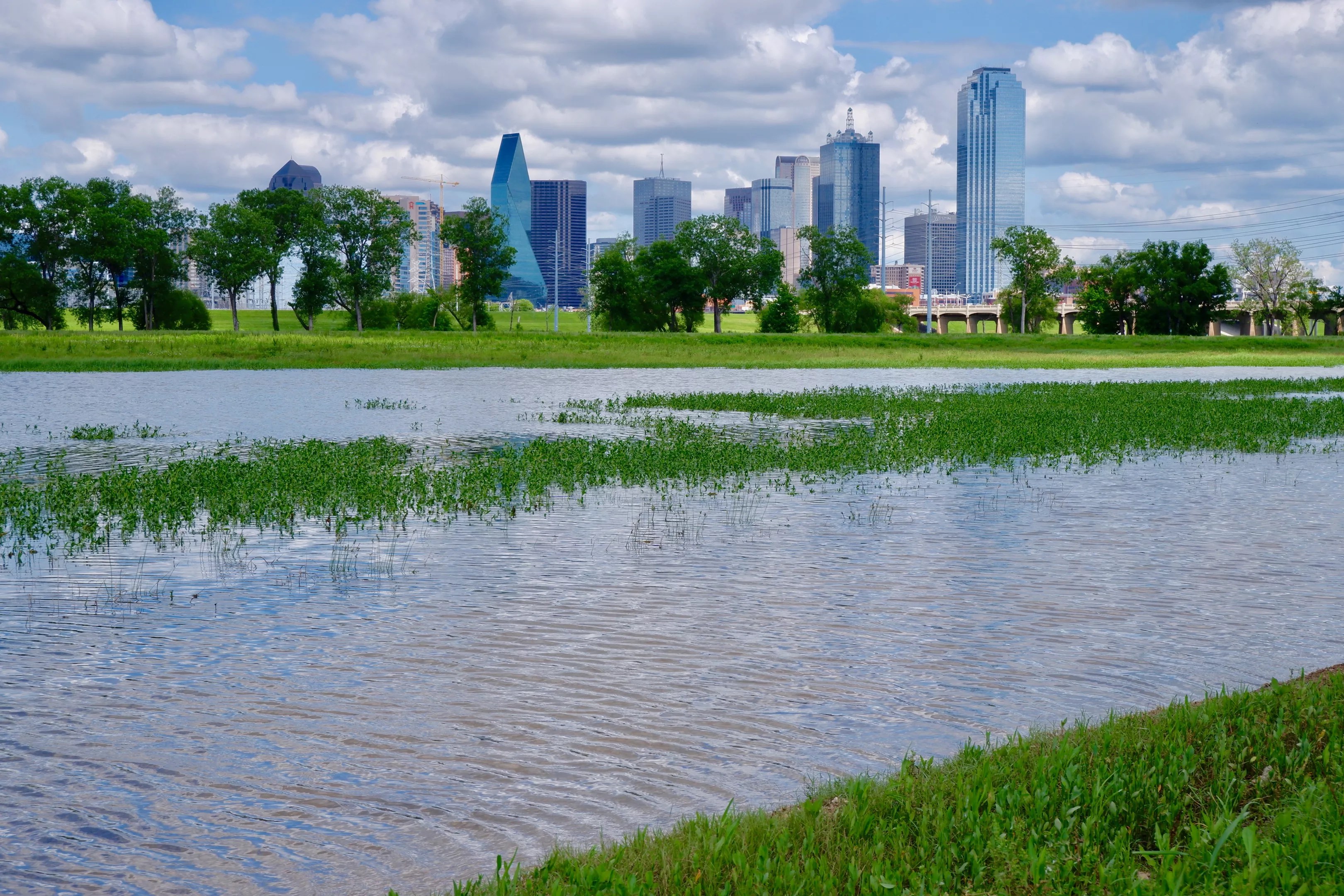
The area they squatted in growing up
Caroline Pritchard
1. Trinity River Squatter’s Camp
The west bank of the Trinity River, near Trinity Groves
The spot is near the west side of the Margaret Hunt Hill Bridge.
Find the hill running along the river. Walk down it, past the people taking engagement photos. The incline is pretty steep. When you reach the mucky area where the ground starts to level out, you’ve arrived.
This is where Clyde Barrow grew up. In a tent, in the mud, with the Dallas skyline looming in the distance. When Guinn was writing Go Down Together he came to this spot often.
“Whenever I felt I was losing the thread a little, I would go over there and I would look and I would realize what it must have felt like,” he says.
This land wasn’t part of Dallas in the 1920s, when the Barrow family moved here from Ellis County. It wasn’t annexed until 1952.
Before then, when you crossed the river you were in Cement City, so named because it was formed in the mid-19th century by cement companies like Trinity Portland Cement Co. to house their employees, who were laying the foundation of Dallas.
The first few months the Barrows lived in the squatter’s camp along the Trinity they slept under their wagon because they couldn’t afford a tent. Even on a mild spring day you can get a sense of the despondency Clyde must have felt growing up here.
“It’s so miserable all around you, and yet you look across the water and there are these shiny buildings where people are wearing fancy clothes, where you can look in shop windows and see so many things that you want to have but you can’t have them,” Guinn says.
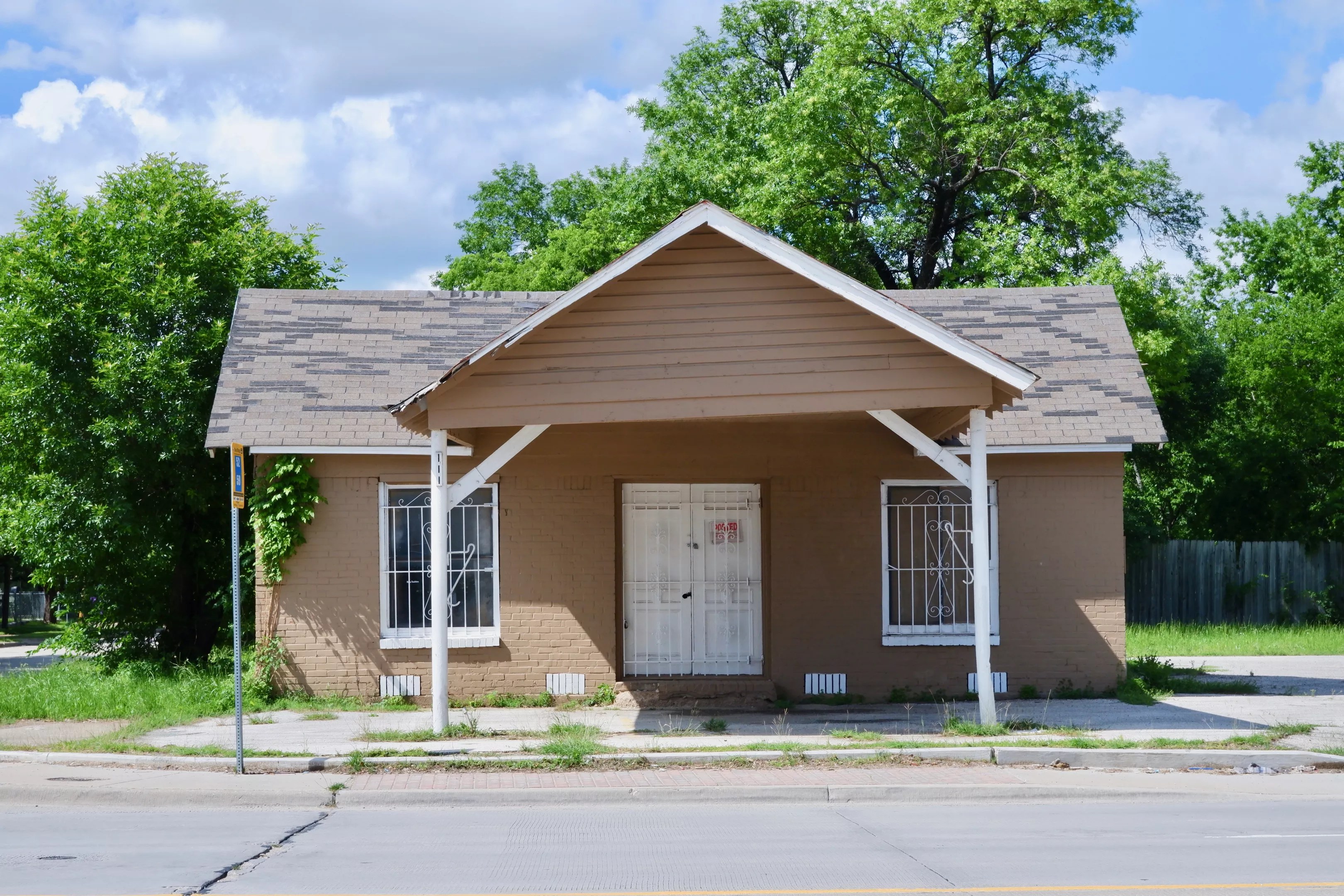
Clyde Barrow’s childhood home
Caroline Pritchard
2. Clyde’s Childhood Home
1221 Singleton Blvd.
Find Singleton Boulevard and head west. When you reach Borger Street, you’ll see an abandoned, beige, single-story building on the corner.
This is the home Clyde’s parents, Henry and Cumie Barrow, purchased for their family of nine once they had saved up enough money to move from the squatter’s camp.
In the 1930s, the street this home sits on was called Eagle Ford Road, not Singleton. The name changed in 1942, allegedly because of unfavorable associations with poverty – and, yes, Bonnie and Clyde.
According to the Oak Cliff Advocate, the Barrows’ home was originally located on nearby Muncie Avenue, but they moved it here so they could turn it into a filling station. They continued to live in the back.
Today the back porch of the filling station is covered in trash. The words “Crips” and “West Dallas” are written in red spray paint on the exterior walls.
The Austin, one of West Dallas’ many brand-new apartment complexes, casts a shadow from across the street. Studios start at $1,200 a month.
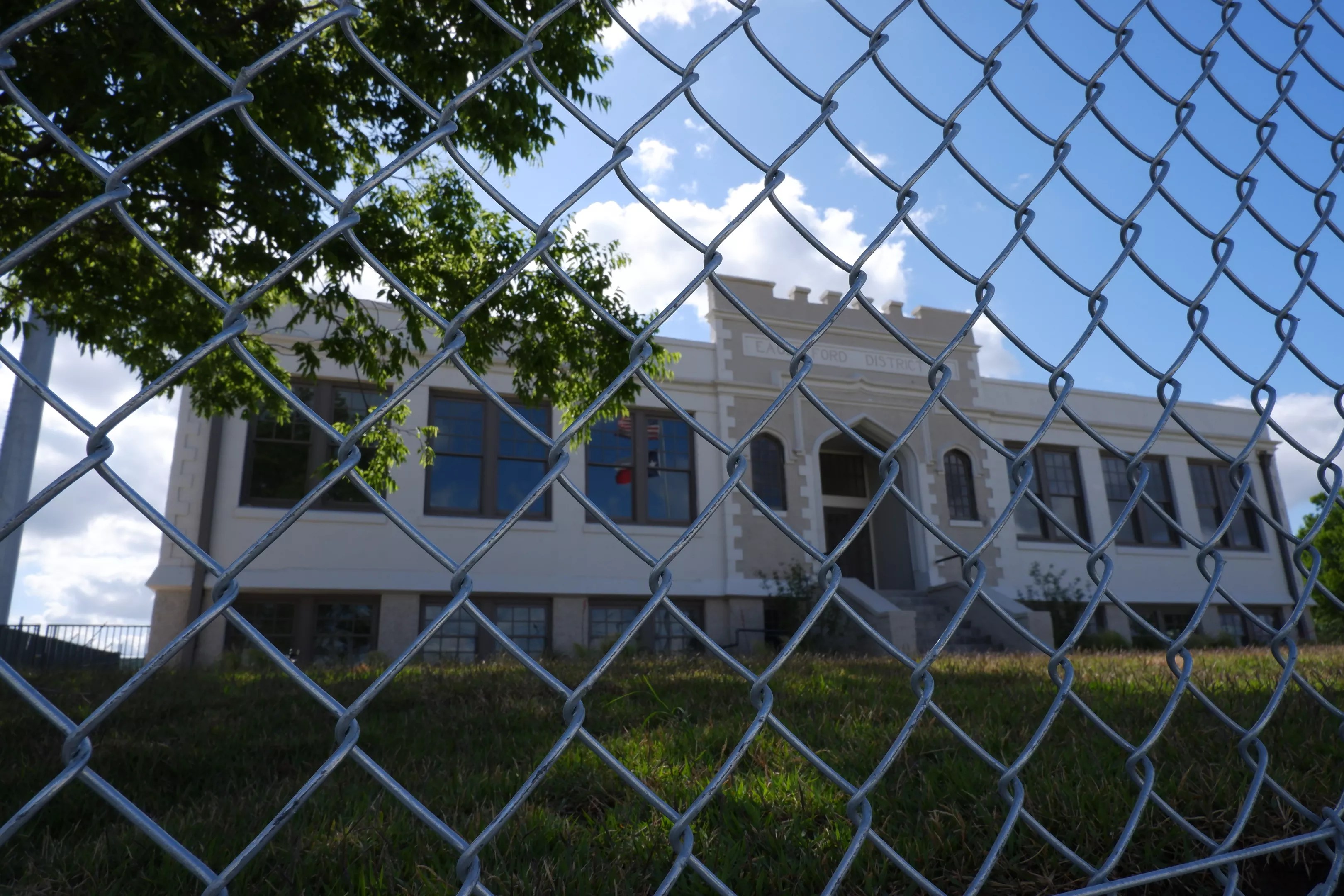
Eagle Ford School
Caroline Pritchard
3. Eagle Ford School
1601 Chalk Hill Road
This 95-year-old elementary where Bonnie attended is much less spooky. In 2017, the Dallas Landmark Commission saved the Eagle Ford School in West Dallas from demolition, setting into motion a chain of events that ended with investor Larry Moser purchasing it for office space.
The property is cordoned off with intimidating chains and “no trespassing” signs, but from the outside the spiffing up looks nearly complete, including a paint job that took the structure from a mottled terra-cotta color to a generic but neat-looking gray.
Even with the coat of paint, the building sticks out on desolate Chalk Hill Road. It looks a bit like a miniature Medieval Times, an aesthetic that lends itself to scary stories, of which the internet holds many. (Don’t visit if you’re especially afraid of satanists.)
“Bonnie was a very intelligent, capable woman. That was part of the problem for her.” – Jeff Guinn
Bonnie came to school here after moving with her mother and siblings from Rowena, where she was born, to her grandparents’ home in Cement City. The impetus was the death of her father, who died when she was 4.
Most of Bonnie’s classmates at Eagle Ford would have been Mexican immigrants. The school was designated a landmark partly because it’s one of the last reminders of the immigrant communities that built Dallas.
At Eagle Ford and later on at Cement City High School, Bonnie was regarded as a good student. She dreamed of being a famous poet or actress.
“Bonnie was a very intelligent, capable woman,” Guinn says. “That was part of the problem for her. She was an outstanding student in school, but there was never any question that a poor girl like her gets to go to college.”
As a teenager Bonnie demonstrated a taste for bad boys. She married a man named Roy Thornton, who drifted in and out of jail, and they were still married at the time of her spree with Clyde.
This wasn’t a case of a good girl being led astray. There’s ongoing debate about the extent of Bonnie’s participation in the Barrow Gang’s crimes across the South and Midwest, but even if she didn’t frequently pull the trigger, Guinn says she was still plenty responsible.
“Clyde was the acknowledged leader of the Barrow Gang – they followed his orders, his instructions – but Bonnie was certainly not only supportive, but she would I think encourage him to keep going,” he says.
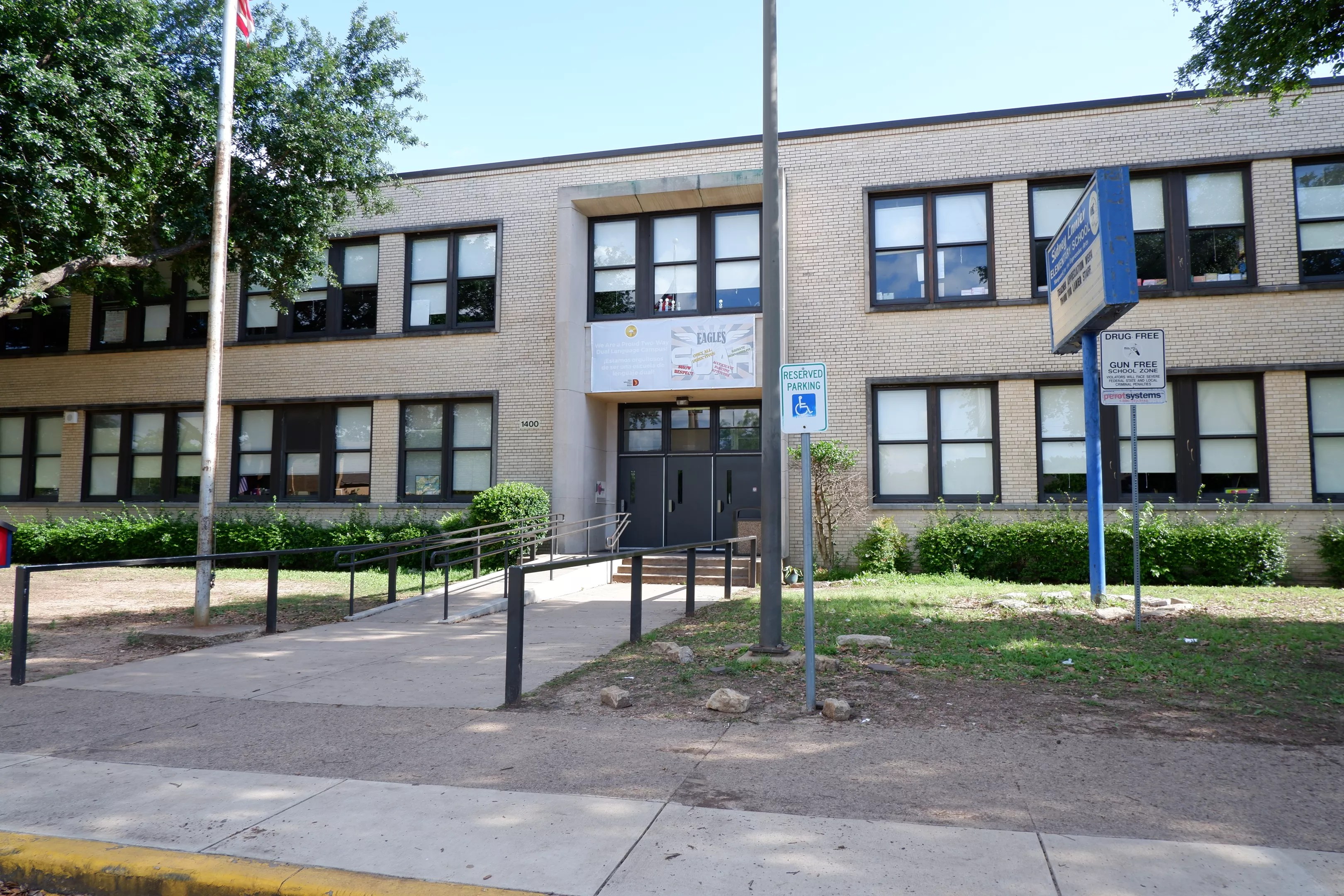
Where Clyde briefly attended sixth grade
Caroline Pritchard
4. Sidney Lanier Expressive Arts Vanguard
1400 Walmsley Ave.
Clyde briefly enrolled in sixth grade at Sidney Lanier Elementary before quitting school altogether. He went on to take a few jobs, but he also started stealing. He was arrested for the first time at 17.
It’s voting day when we pay a visit to Sidney Lanier, which is still functioning as a school and also serves as a voting location. The lawn is covered in campaign signs.
Among them is a man carrying one for Dallas City Councilman Omar Narvaez. “Taking a glamour shot of me?” he says as we snap shots of the school’s exterior.
His name is Todd Hill-Jones. Not only does he know that Clyde went to school here, but he also has an interesting relationship to the outlaws. One of the police officers they killed, H.D. Murphy, is his great, great uncle.
“It’s an example of the service and sacrifice our family has made,” Hill-Jones says. Murphy and his partner thought they were making a routine stop to attend to a broken-down vehicle when they were shot by Clyde and fellow Barrow Gang member Henry Methvin, with Bonnie also in the car.
Hill-Jones still has family in the law, including his sister. They were talking about Murphy’s death just the other day. “She was mentioning that traffic stops may seem innocent to some people,” he says.
Asked if it upsets him that his uncle’s murderers are romanticized, he says yes, and blames the misconceptions on Hollywood.
“We need to do a better job of showing the whole story,” he says. There is no bitterness in his voice.
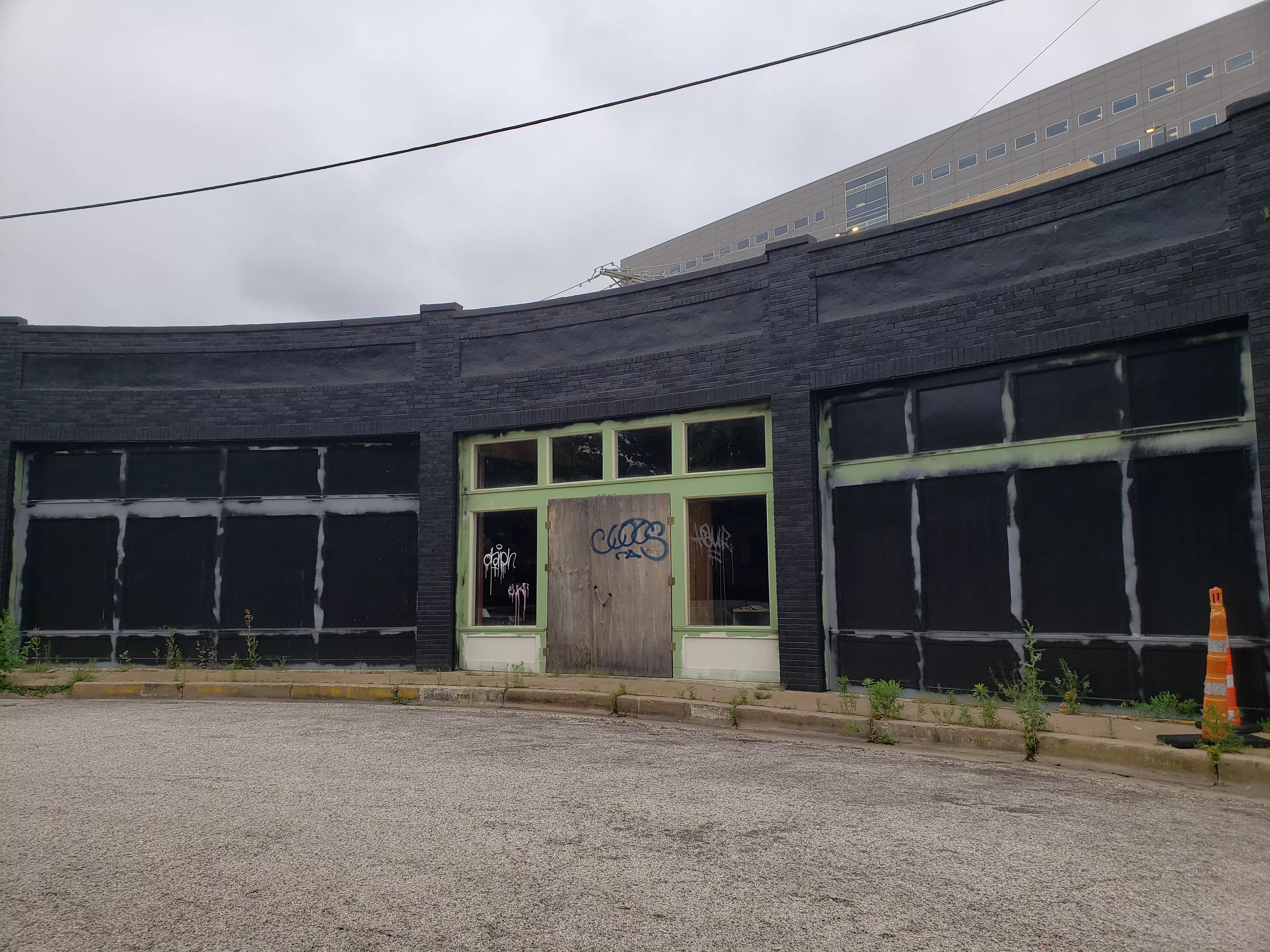
The shell of Hartgraves Caf
Caroline Pritchard
5. Hartgraves Café
3302 Swiss Circle
Bonnie began working at Hartgraves Café on Swiss Avenue in 1928, after separating from her husband.
Barrow also held jobs in this area, at United Mirror and Glass just down the street on Swiss, and at the Brown and Cracker Candy Co., which later became the Marketplace Building in the West End.
Neither of those structures are recognizable today – the Marketplace Building is now an office building that includes a coworking space – but the café still stands on the fringes of Deep Ellum, right next to Baylor University Medical Center.
The quaint, curved building has been painted an unfortunate matte black and the insides are gutted. As recently as 2015 there were plans to turn it back into a restaurant, but those seem to have been abandoned.
In the 1983 book Reminiscences: A Glimpse of Old East Dallas, a woman who worked at the laundry across the street from Hartgraves Café recalls her experiences with Bonnie.
“Ofttimes, we would want things from the cafe, but we were not allowed to go across the street during working hours. We’d go to our front door and whistle, and she’d come to their back door from the cafe and come and take our orders and go back and fill them and bring them back to us,” Rose Myers said. “She was a real nice person.”
Guinn says the waitress position would have been a pretty good get for Bonnie.
“Bonnie is an ambitious poor girl in a time when women in East Dallas, if they were young and pretty, had three choices,” he says. “They could work in factories, if they were lucky they could be shop girls, or they could be prostitutes.”
One of Bonnie’s regular customers at Marco’s, another cafe where she worked, was Ted Hinton, who later became a deputy and participated in the ambush that killed her.
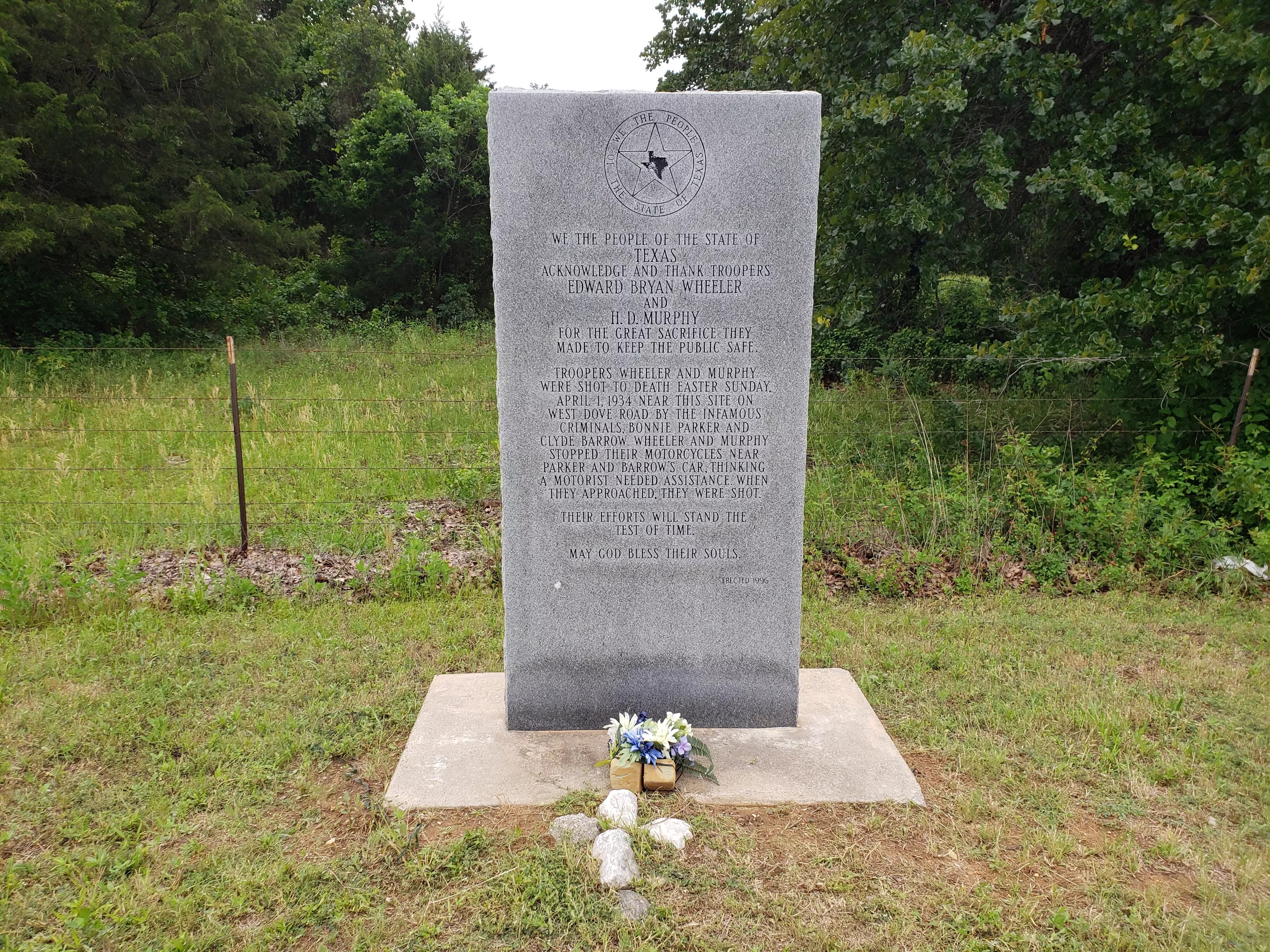
Memorial to Murphy and Wheeler
Caroline Pritchard
6. Memorial to State Troopers H.D. Murphy and Edward Wheeler
State Highway 114 and West Dove Road, Southlake
State troopers H.D. Murphy and Edward Wheeler were young and new to the job when they rode up to Bonnie and Clyde’s car on April 1, 1934.
A six-foot-tall granite memorial erected on West Dove Road in Southlake, near the location where the officers stopped, tells the rest of what happened.
“Wheeler and Murphy stopped their motorcycles near Bonnie and Clyde’s car, thinking a motorist needed assistance,” the memorial reads. “When they approached, they were shot. Their efforts will stand the test of time.”
According to the Officer Down Memorial Page, which honors police officers killed in the line of duty, Murphy was 22 and Wheeler 26 when their paths crossed Bonnie and Clyde. They had been on the job just six months and four years, respectively.
“I want the world to know what vicious killers and murderers they are.” – Doris Edwards
Murphy left behind a fiancée, who wore her wedding dress to his funeral. Wheeler was survived by his wife of two years, Doris Edwards.
The memorial and its surroundings are more pristine than any other entry in this guide. It’s worth a visit, but hard to reach.
Bonnie and Clyde had used West Dove Road as part of their escape path. They would head west on Eagle Ford Road and then north toward Grapevine. Back then these were country roads.
Today West Dove Road has four busy lanes. The memorial is on the southern, sidewalk-less side, facing a Verizon Wireless corporate office. To get to it, you’ll have to park across the street and jaywalk. The memorial in Southlake was a triumph for Edwards when it was finally erected in 1996.
“It’s just stayed inside me and festered all this time – all the publicity on Bonnie and Clyde, glamorizing them,” she told an Associated Press reporter. “I want the world to know what vicious killers and murderers they are.”
The Barrow Gang killed nine police officers before they were through.
7. Dallas County Criminal Courts Building
Main and Houston streets
When you drive by the Dallas County Criminal Courts Building you’ll wonder how you never noticed it before. The stone work is breathtaking.
At one time this building, one of three that make up the Records Complex, was the pride of the city. Finished in 1915 at a cost of $675,000, it consisted of offices for the sheriff and county attorney, courtrooms, jury rooms and a cutting-edge jail.
The jail was special because it was reputed to be “escape proof” and it was also pretty luxurious, with amenities including a barbershop, chapels and a gym. According to The Dallas Morning News, three days were set aside just for public tours when it opened.
Clyde Barrow spent time there before he met Bonnie. Later, it was headquarters for Dallas County Sheriff Smoot Schmid and deputies Bob Alcorn and Hinton, as they helped Hamer to hunt the couple down.
“The minute Frank Hamer, a really good professional lawman, was on their trail they were doomed,” Guinn says.
Although the Records Complex was built to last – at the time of its construction, an expert told the DMN it could house “all records of the county that may develop during the next 100 years” – parts of it closed as early as the ’60s.
Today all that exists of the Criminal Courts Building is the facade. The Dallas County Records Complex is undergoing a $138 million renovation, scheduled to be finished in 2020.
As part of the project, the entire interior of the Criminal Courts Building was demolished, but not before removing the cell that housed Clyde Barrow.
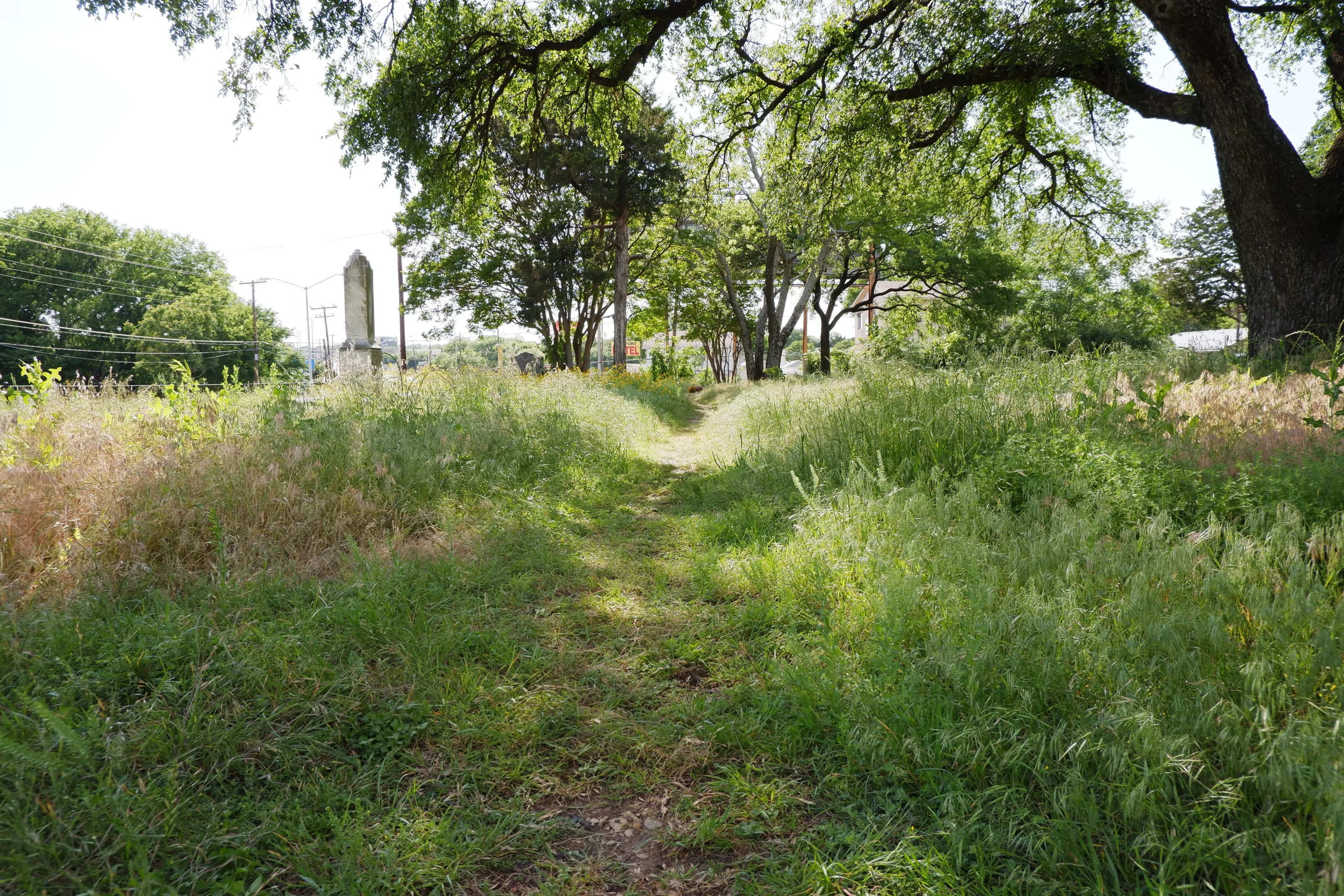
Path to Clyde’s grave
Caroline Pritchard
8. Clyde’s Grave
Western Heights Cemetery, 1617 Fort Worth Ave.
Visitors have left their mark on the overgrown Western Heights Cemetery. Their footprints have pressed the grass down, carving a path to the Barrow family plot.
Clyde and his brother Marvin “Buck” Barrow share a grave near their mother. Next to them is an empty spot, which living relatives of Bonnie and Clyde hope someday Bonnie will fill.
A historical marker in the cemetery, which dates to the 1850s, reveals Western Heights Cemetery is also home to veterans of the Civil War and both World Wars, along with other prominent early settlers of North Texas.
There are no paths to those graves.
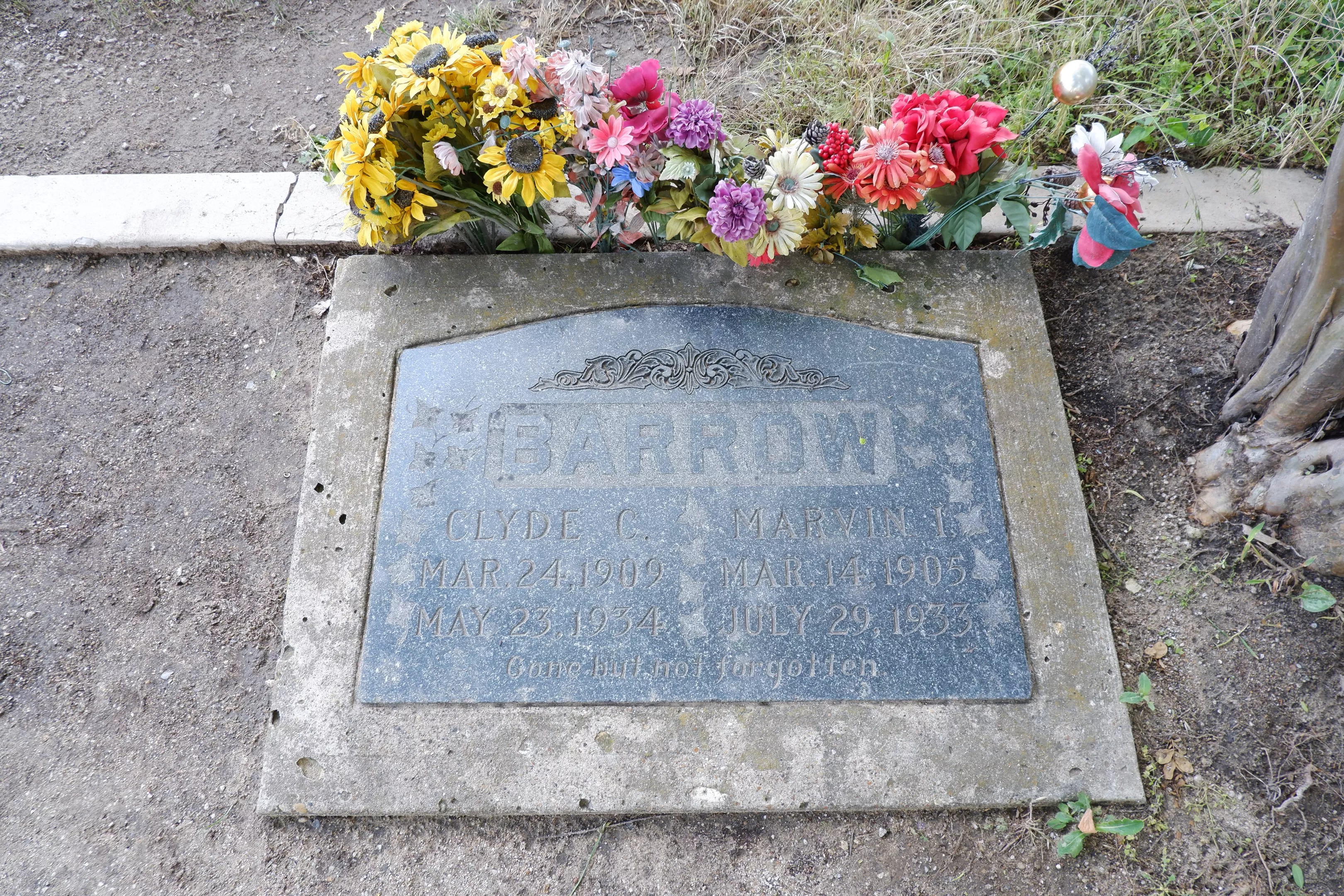
Clyde’s grave
Caroline Pritchard
Clyde Barrow is clearly Western Heights Cemetery’s most popular resident. In 20 minutes’ time on a Saturday, two couples approach to see the place where Barrow is laid to rest.
One man who came with his wife tells us that he’s lived in the area for many years but had never before visited. “My wife wanted to see it,” he says.
The Barrows’ graves aren’t much to look at. The cemetery’s neighbors are a Comfort Motel and a public storage facility.
But there’s little doubt that their infamy earned them better accommodations than most of their peers from the squatter’s camp. Before Clyde was buried, his body was laid for viewing in Belo Mansion downtown; 10,000 people showed up to see him.
Over the years, the marker reading “Gone but not forgotten” has required additional cement reinforcement.
“For years, the Texas-OU weekend seemed to be a favored time of those who would sneak in and take the marker away,” historian John Neal Phillips told the Observer in 2000. “Once, in fact, Dallas police traced it to a pregame party, where it was being used as a coffee table.”
Bonnie and Clyde have always attracted souvenir hunters. Shortly after they were killed, deputy Hinton caught someone trying to cut off Clyde’s trigger finger. Guinn says people still show up to the site in Louisiana to pick apart any tributes. To him it’s proof of the ongoing fascination with the couple, which he believes to be growing.
“They were products of a time when the gulf in America between the rich and poor was very wide, which is another reason why I think they’re sort of coming back into popularity now,” he says.
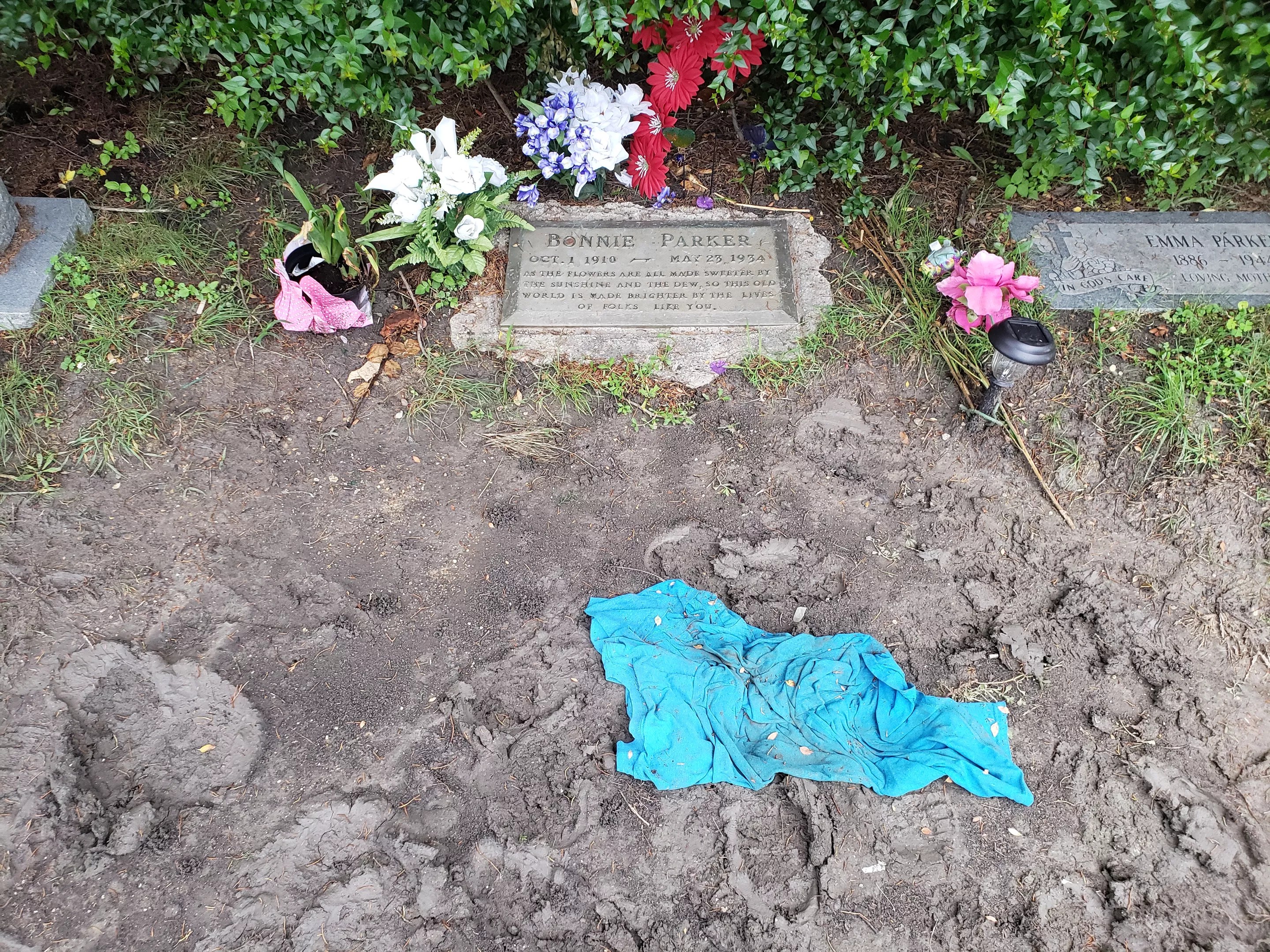
Bonnie’s grave
Caroline Pritchard
9. Bonnie’s Grave
Crown Hill Memorial Park, 9178 Webb Chapel Road
Bonnie’s mother Emma Parker wasn’t too fond of Clyde. “In a sense, who can blame her?” Guinn says.
Emma Parker made her feelings clear after their deaths by refusing to honor Bonnie’s wishes to be buried alongside Clyde.
Instead, Bonnie was laid to rest in nearby Fish Trap Cemetery. More than 20,000 people attended that service.
In 1945, Bonnie was moved farther away, to Crown Hill Memorial Park near Bachman Lake. That’s where she remains today, beneath a marker that bears the surprisingly saccharine words: “As the flowers are all made sweeter by the sunshine and the dew, so this old world is made brighter by the lives of folks like you.” Her mother is buried next to her.
Clyde’s grave isn’t well-maintained, but Bonnie’s is even less so. It’s misty on the day that we visit, and the dirt over her grave looks like a music festival campground. A blue rag is strewn among the mud puddles.
But if Rhea Leen Linder and Buddy Barrow have their way, Bonnie won’t be here much longer. They are the niece and nephew of Bonnie and Clyde, and they are leading a charge to reunite them.
Guinn says he hopes it happens, but whatever the outcome, he feels sure Bonnie and Clyde would be satisfied with how their choices played out.
“If they could come back today and see how much they’re still in the public mind,” he says, “they would have thought that everything else was worth it.”